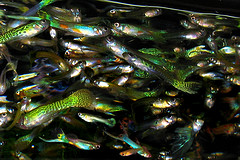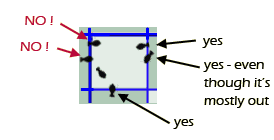Counting Guppies
 In the app below, you will help Nemo count guppies -- but not every guppy in the tank! Nemo's got a social life, after all. Instead, you'll only count the guppies in the top, middle, and bottom of the highlighted squares.
In the app below, you will help Nemo count guppies -- but not every guppy in the tank! Nemo's got a social life, after all. Instead, you'll only count the guppies in the top, middle, and bottom of the highlighted squares.
Once you know the number in each square, you add them all up, then divide by the volume just the area you counted.
Don't skip this NOTE: As before, we are assuming that you have a sort of "snapshot" of the tank, so we don't need to worry about fish moving around. But there is still a slight problem. What if a fish is "halfway" in one square and "halfway" in another? Like this:

It might seem to be a good idea to count fish that are "halfway or more" into the gridsquare, but actually it's NOT. The reason is that it introduces some subjectivity -- and worse yet, takes extra time, which could be better spent out having a social life...
We certainly don't want to count EVERY fish that is partway in the gridsquare, because that way we could overcount (for example, if we counted the adjacent gridsquare, any "in between" fish would get counted twice). And we don't want to count none of them, because then we'd be undercounting.
So, a compromise: we count only fish that touch the BOTTOM or RIGHT sides of the gridsquare. Even if they are just barely touching, almost entirely outside of the gridsquare. That way, no danger of under- or over-counting, less thinking and calculating, and more time outside the lab. Win-win.

Now you have all of the tools you need to deal with a hemocytometer:
- you are used to counting organisms on multiple layers
- you know when an organism is in or out of the gridsquare
- you know how to calculate density per volume
- you know how to use sub-sampling to win a little more free time.
It's time to jump down to the microscopic level...
photo credits:guppy mosh pit
Copyright University of Maryland, 2007
You may link to this site for educational purposes.
Please do not copy without permission
requests/questions/feedback email: mathbench@umd.edu